So you thought that chilli pepper was a small, strong, spicey fruit? Well, it is... but it's also a seemingly popular name for fishing flies. In the past I have come over no less than three patterns with the name Chilli Pepper.

So you thought that chilli pepper was a small, strong, spicey fruit? Well, it is... but it's also a seemingly popular name for fishing flies. In the past I have come over no less than three patterns with the name Chilli Pepper. And I'm sure that there are more out there.
The first Chilli Pepper I ever saw was actually called Chile Pepper and was tied By the US tyer Phil Strobel while he was visiting The Bananaflies here in Denmark. He was inspired to tie this fly by seeing the Omoe Brush. The fly was originated by Marcos Vergeras, formerly of Fly&Field. The Chile Pepper was originated by both he and Bill Hurrell while on an excursion to Tierra del Fuego. It uses Golden Pheasant feathers solely. It's very simple to tie, utilizing the New Zealand Mrs. Simpson style of applying the feathers on the side of the hook shank. Phil tied a sample fly that evening, and I kept it as a memory and thought no more of it.
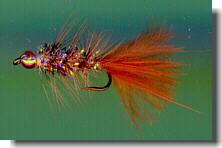
But a couple of years later there was a second Chilli Pepper mentioned on the FF@ fly fishing mailing list. This fly was introduced by Tony Spezio, whose friend Bob Root was the originator. I was lucky enough to exchange some flies with Tony, and a couple of Chilli Peppers were included in Tony's bunch.
The last Chilli Pepper that I know was brought about - also on FF@ - by Aaron Adams of The Virgin Islands. This Chilli Pepper is a salt water pattern and a variation of the well known Crazy Charlie. It's not Aaron's own pattern, but none of us know the origin. Hence it's dubbed Aaron Adam's Chilli Pepper
Phil Strobel's Chile Pepper
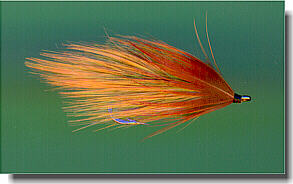
| Hook | Tiemco TMC 200 #2 |
| Thread | Red or black |
| Body | Rows of yellow G.P. body feathers |
| Cheeks | Red G.P. body feather |
| Head | Red or black |
- Tie in a yellow G.P. body feather as a tail approx. three quarters shank length
- Advance the thread forwards one third of the shank length
- Tie a pair of yellow G.P. body feathers vertically on each side of the shank - 'Mrs. Simpson style'
- Advance the thread one more third
- Tie in one more pair of yellow feathers vertically
- Wind the thread to one eye width behind the hook eye
- Tie in one more pair of red G.P. body feathers as cheeks reaching almost to the hook bend
- Form a nice, small head from the tying thread
- Whip finish and varnish
Says Phil Strobel:
- I learned my version of the Chili (actually Chile) Pepper from one of the originators Marcos Vergara.
Phil tells that Marcos was born in Chile and runs a fishing camp there. Marcos has had success using the Chile Pepper for the huge sea run brown trout
that frequent the rivers of Chile. Phil concludes:
- I have found it to be a useful pattern for stream resident brown trout here in the states.
Bob Root's Chilli Pepper
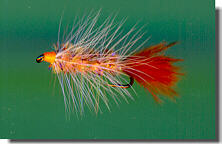
Bob Root's own Chilli Pepper
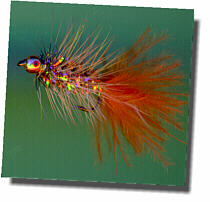
Tony Spezio's version of Bob Root's Chilli Pepper
| Hook | Mustad 9672 or 79580 #6-14 |
| Weight | 20 wraps lead wire |
| Thread | Fluo orange |
| Tail | Burnt orange marabou |
| Hackle | Dark ginger or furnace saddle hackle |
| Body | Bronze or Copper Mylar Chenille. Bob has a special mix of chenille that he has Danville make up for him. It has pearlesent mixed with the copper. |
| Head | Fluo orange or gold 5 mm bead with small painted eyes. |
- Add optional weight in the form of lead wire or a gold bead
- Tie in a tail on top of the hook shank. Length approx. half shank length. The butt ends of the marabou can cover the whole hook shank to form a thicker body
- Tie in hackle pointing upwards, tip first, shiny side in
- Tie in the chenille, agin covering the shank for a thicker body
- Advance the tying thread to one eye width behind hook eye or right behind bead head
- Follow with close wraps of the chenille
- Tie down and cut surplus
- Wrap the hackle in the opposite direction of the chenille. Make shure the fibers lie nicely and point backwards
- Tie down and cut surplus
- Form a head from the tying thread
- Whip finish and varnishor
- Whip finish just behind the bead and varnish
- Paint eyes on the bead head
Aaron Adam's Chilli Pepper
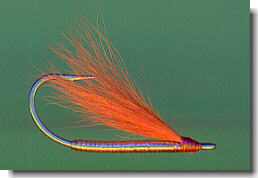
Original version of the Chilli Pepper
| Hook | Mustad 34007 #2 |
| Thread | Red flatwaxed nylon |
| Body | Gold mylar wrapped around hook shank from eye to bend. Clear mono wrapped over mylar |
| Wing | Fine apricot/orange bucktail or calftail |
| Head | Color of thread |
- Tie in the thread one eye width behind the hook eye
- Tie in the monofile under the hook shank
- Cover shank and monifile with a smooth layer of thread to the hook bend
- Wrap the thread back to just behind the hook eye forming a smooth base for the tinsel
- Tie in gold tinsel
- Wrap the tinsel to the hook bend and back to form a smooth layer of gold
- Tie down and cut surplus
- Cover the tinsel body with touching wraps of monofile.
- Tie down and cut surplus
- Turn the hook upside down
- Tie in a bunch of hair as a false hackle/wing. Tips should touch and slightly cover the hook point
- Trim the butts
- Form a head over the butts
- Whip finish and varnish
Aaron's notice: For deeper water I wrap lead wire around the hook shank prior to wrapping the mylar.
Martin's notice: The fly can be tied with almost any type of orange hair. Arctic fox or squirrel will do fine too. Dumbbell eyes can be tied in on top of the shank to add weight and secure an upside-down position in the water.
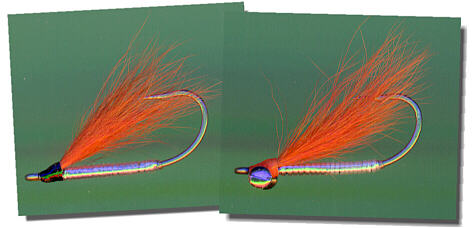
Chilli Pepper variations. Left: with silver body and black head. Right: a version with dumbbell eyes for weight.
- Log in to post comments

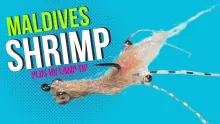
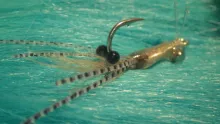


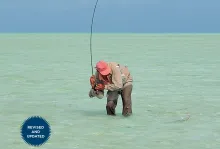


Great, great page, I
Great, great page, I really enjoy the articles and reviews. Love the chilly flies. I will try tying it and use it on catching all sort of NW salt and freshwater species.